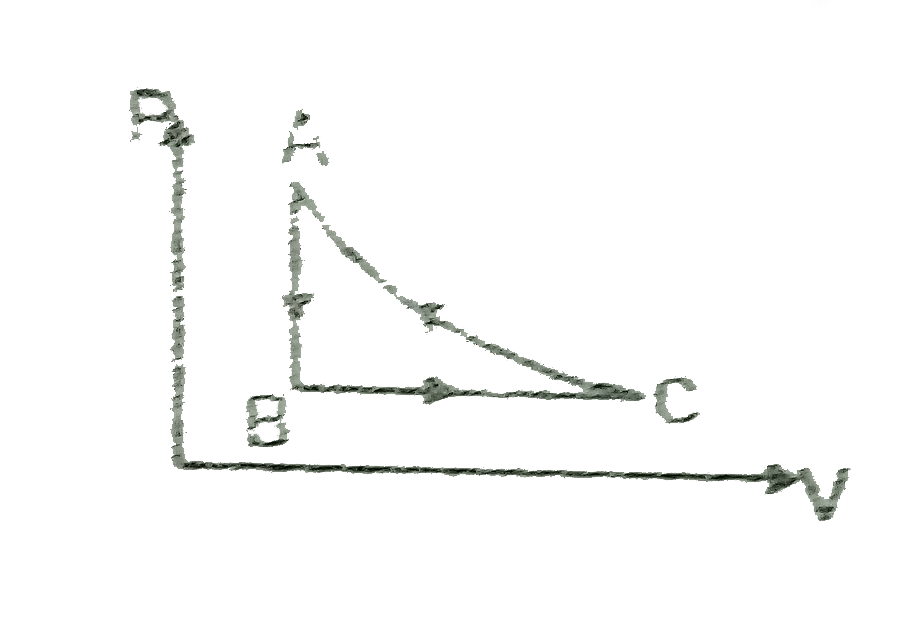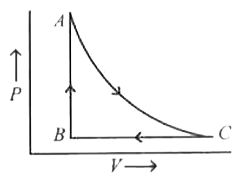In figure, a cyclic process ABCA of 3 moles of an ideal gas is given. The temperature of the gas at B and C are 500k and 1000K respectively. If work done on the gas in process CA is 2500J then find the net heat absorbed or released by an idela gas. Take R=25/3J/mol−K.

The change in internal energy during the cyclic process is zero. Hence , the heat supplied to the gas is equal to the work done by it. Hence,
ΔQ=WAB+WBC+WCA……….(i)
The work done during the process AB is zero
WBC=PB(VC−VB)
=nR(TC−TB)
=(3mol)(25/3J/mol−K)(500K) ltbr> =12500J
As WCA=−2500J (given)
∴ΔQ=0+12500−2500 [from ..........(i)]
ΔQ=10kJ

Topper's Solved these Questions
- KTG & THERMODYNAMICSBOOK - RESONANCECHAPTER - KTG & THERMODYNAMICSEXERCISE - Solved problem
1 Videos
- KTG & THERMODYNAMICSBOOK - RESONANCECHAPTER - KTG & THERMODYNAMICSEXERCISE - Problem
3 Videos
- KTG & THERMODYNAMICSBOOK - RESONANCECHAPTER - KTG & THERMODYNAMICSEXERCISE - SUBJECTIVE QUESTIONS
27 Videos
- KINETIC THEORY OF GASES AND THERMODYNAMICSBOOK - RESONANCECHAPTER - KINETIC THEORY OF GASES AND THERMODYNAMICSEXERCISE - Exercise
64 Videos
- MAGNETIC FIELD AND FORCESBOOK - RESONANCECHAPTER - MAGNETIC FIELD AND FORCESEXERCISE - Exercise
65 Videos
Similar Questions
 Consider the following cyclic abcda performed on 2 mole of an ideal gas. The temperature of the gas at b and c are 400 k and 300 k respectively. Calculated the heat absorbed by the gas during the process in calories.
Consider the following cyclic abcda performed on 2 mole of an ideal gas. The temperature of the gas at b and c are 400 k and 300 k respectively. Calculated the heat absorbed by the gas during the process in calories.
View Solutionconsider the cyclic process ABCA on a sample of 2.0 mol of an ideal gas as shown in the temperature of the gas at A and B are 300 K and 500 k respectively. A total of 1200 J heat is withdrawn from the sample in the process. Find the work done by the gas in part BC. take R=8.3JK−1mol−1

View Solution
Knowledge Check
The cyclic process for 1 mole of an ideal gas is shown in the V-T diagram. The work done in AB, BC and CA respectively is
 A(a) 0, RT2In∣∣∣V2V1∣∣∣,R(T1−T2)B(b) R(T1−T2),0,RT1In∣∣∣V1V2∣∣∣C(c) 0,RT1In∣∣∣V1V2∣∣∣,R(T1−T2)D(d) 0,RT_(2)In|V_2/V_1|,R(T_2-T_1)
A(a) 0, RT2In∣∣∣V2V1∣∣∣,R(T1−T2)B(b) R(T1−T2),0,RT1In∣∣∣V1V2∣∣∣C(c) 0,RT1In∣∣∣V1V2∣∣∣,R(T1−T2)D(d) 0,RT_(2)In|V_2/V_1|,R(T_2-T_1)A cyclic process for 1 mole of an ideal gas is shown in the V-T diagram. The work done in AB, BC and CA respectively are
 A0,RT1ln(V1V2),R(T1−T2)BR,R(T1−T2),RT1ln(V1V2)C0,RT2ln(V1V2),R(T1−T2)D0,RT2ln(V2V1),R(T1−T2)
A0,RT1ln(V1V2),R(T1−T2)BR,R(T1−T2),RT1ln(V1V2)C0,RT2ln(V1V2),R(T1−T2)D0,RT2ln(V2V1),R(T1−T2)One mole of ideal gas undergoes a cyclic process ACBA as shown in figure. Process AC is adiabatic. The temperatures at 1, B and C are 300 K,600 K and 450 K respectively. Choose the correct statement.
 AIn process CA, change in internal energy is 225 R.BIn process AB, change in internal energy is -150 RCIn process BC, change in intenal energy is -225 R.DChange in internal energy during the whole cyclic process is +150 R.
AIn process CA, change in internal energy is 225 R.BIn process AB, change in internal energy is -150 RCIn process BC, change in intenal energy is -225 R.DChange in internal energy during the whole cyclic process is +150 R.
One mole of an ideal gas is heated from 273K to 546K at constant pressure of 1 atmosphere. Calculate the work done by the gas in the process.
View Solutionshows the variation in the internal energy U with the volume V of 2.0 mol of an ideal gas in a cyclic process abcda. The temperatures of the gas at b and c are 500 K and 300 K respectively. Calculate the heat absorbed by the gas during the process.

View SolutionIn a thermodynamic process two moles of a monatomic ideal gas obeys PV–2=constant. If temperature of the gas increases from 300 K to 400 K, then find work done by the gas (Where R = universal gas constant)
View SolutionA cyclic process performed on one mole of an ideal gas. A total 1000 J of heat is withdrawn from the gas in a complete cycle. Find the work. Done by the gas druing the process B→C.

View SolutionFigure shows a cycle ABCDA undergone by 2 moles of an ideal diatomic gas. The curve AB is a rectangular hyperbola and T1=300K and T2=500K. Determine the work done by the gas in the process A→B.

View Solution
